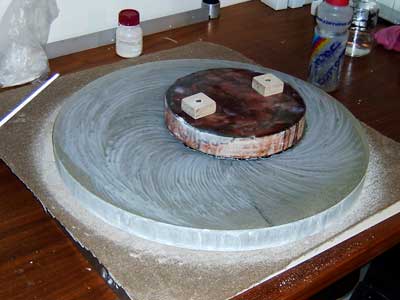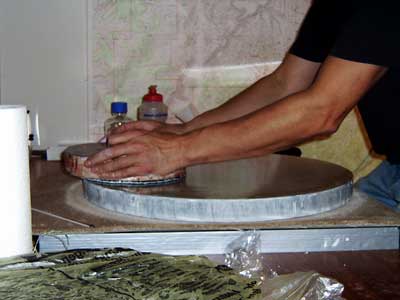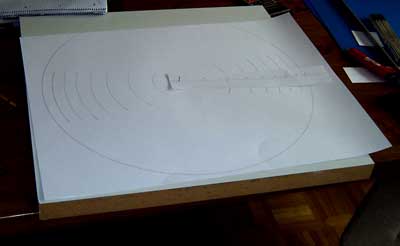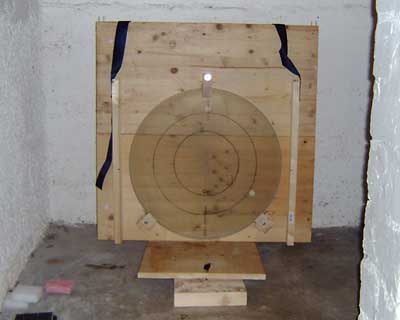For figuring, I used a batch of tools with different diameters. The main figuring tool was a 25 cm pitch lap. As zonal polishers, I used pitch laps with 15 cm, 10 cm, and 5 cm diameter, as well as a special 3cm tool (my right thumb, a very efficient tool !).
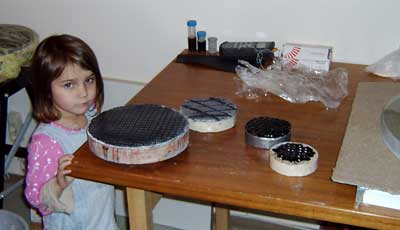
For grooving these smaller laps I used a rubber car mat. Again, the pitch lap is heated head over in a hot water bath and then pressed onto the mirror with the rubber car mat in between. After that, the car mat is replaced by mosquito netting, and finally the tool is pressed once more directly on the mirror.
In the beginning, I had a 28° pitch on the laps, which was replaced later by softer 23° pitch, which was better suited for the low temperature in the basement. With the softer pitch, the surface of the mirror became much smoother.
Small zonal polishers (~ 4-5 cm) where immersed again and again into hot water during figuring to keep them soft. After use of small zonal polishers, I often observed thin sleeks, which were avoided by this method.
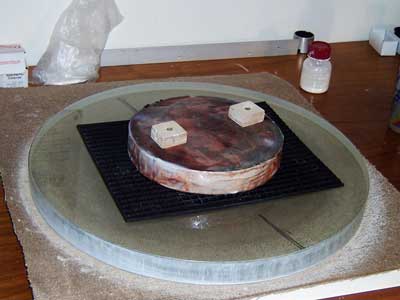
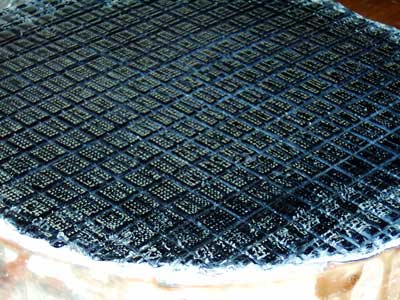
With smaller mirrors, figuring is the art of removing selectively small amounts of glass by well defined polishing strokes over a short time, accompanied and interrupted by many testing sessions. With a 22" f/4 mirror, figuring is still coarse work where several 1000 nm of glass have to be removed from the middle of the mirror. This is really a lot as it has to be removed by pitch and HPC and not by grinding.
An efficient method
to deepen the middle is shown to the right. The tool is moved slightly
offset center-over-center, while applying selective pressure (and I mean
real pressure!) on that side of the tool that is above the center. One has
to take care to do this very evenly and to rotate the mirror permanently
to maintain rotational symmetry. If I had to figure such a big mirror
again (what I certainly will not do
![]() ),
I would make a rotating support for the mirror, where the mirror is kept
automatically at constant speed.
),
I would make a rotating support for the mirror, where the mirror is kept
automatically at constant speed.
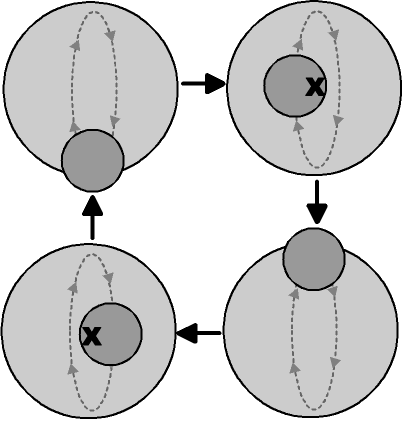
During figuring, I tried different techniques, of which some worked, while others did not. By try and error, you can find out how certain strokes affect the figure of the mirror (which could be different for different mirror makers).
In principle, I first deepened the middle by selective pressure to the edge of the tool. This took several evenings. Then I broadened this depression by circular "rosetta" strokes, extending the figure to the periphery of the mirror in order to arrive at a roughly parabolic figure. Finally, zonal errors were corrected with smaller laps.
Several times, I used my thumb for work inside the edge of the mirror to prevent a rolled edge.
For zonal Foucault testing, I used a 12 zone Couder mask.
For testing, the mirror was rested on two Teflon pads supporting the mirror in the middle of its edge, that were mounted at a 90° angle on freely rotating wooden blocks.
In general, the
Foucault profiles derived for different diameters were not completely
identical ![]() .
This is probably normal if such a big mirror is parabolized by subdiameter
tools.
.
This is probably normal if such a big mirror is parabolized by subdiameter
tools.
I used different testing methods, including interferometry, and also tried Dall and Ross tests. Finally, I ended up again with regular Foucault test and artificial star test in the center of curvature, sometimes complemented by true star testing, which of course requires exceptional seeing.
Twice I corrected
"obvious" deviations from rotational symmetry by asymmetric
figuring. But what is "obvious"? Anyways, such trials are always
like playing with fire
![]() !
!
I declared the mirror finished after the single surface profiles over four different diameters had independently an encircled energy ratio above 0.9 (and above 0.95 in the mean). In the artificial star test in the center of curvature, no astigmatism or other deformations were discernible. Also in the true star test no astigmatism or other obvious deviations were visible, which is, of course, limited by the atmospheric seeing. Under our regular seeing conditions, a reasonable judgment of the focal star image is not possible.
